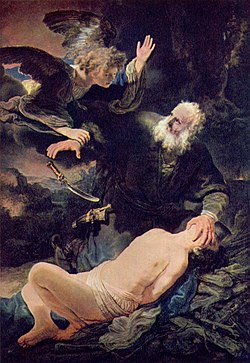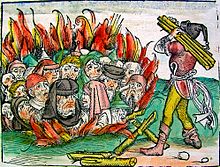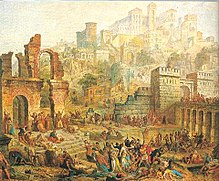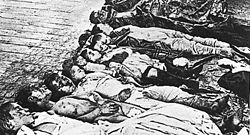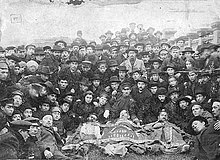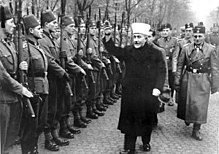1st Row, proto-Maskilim: Raphael Levi Hannover • Solomon Dubno • Tobias Cohn • Marcus Elieser Bloch
2nd Row, Berlin Haskalah: Salomon Jacob Cohen • David Friedländer • Naphtali Hirz Wessely • Moses Mendelssohn
3rd Row, Austria and Galicia: Judah Löb Mieses • Solomon Judah Loeb Rapoport • Joseph Perl • Baruch Jeitteles
4th Row, Russia: Avrom Ber Gotlober • Abraham Mapu • Samuel Joseph Fuenn • Isaac Baer Levinsohn
2nd Row, Berlin Haskalah: Salomon Jacob Cohen • David Friedländer • Naphtali Hirz Wessely • Moses Mendelssohn
3rd Row, Austria and Galicia: Judah Löb Mieses • Solomon Judah Loeb Rapoport • Joseph Perl • Baruch Jeitteles
4th Row, Russia: Avrom Ber Gotlober • Abraham Mapu • Samuel Joseph Fuenn • Isaac Baer Levinsohn
The Haskalah, often termed Jewish Enlightenment (Hebrew: השכלה; literally, "wisdom", "erudition"), was an intellectual movement among the Jews of Central and Eastern Europe, with certain influence on those in Western Europe and the Muslim world. It arose as a defined ideological worldview during the 1770s, and its last stage ended around 1881, with the rise of Jewish nationalism.
The Haskalah pursued two complementary aims. It sought to
preserve the Jews as a separate, unique collective and worked for a
cultural and moral renewal, especially a revival of Hebrew
for secular purposes, pioneering the modern press and literature in the
language. Concurrently, it strove for an optimal integration of the
Jews in surrounding societies, including the study of native vernacular
and adoption of modern values, culture and appearance, all combined with
economic productivization. The Haskalah promoted rationalism,
liberalism, freedom of thought and enquiry, and is largely perceived as
the Jewish variant of the general Age of Enlightenment.
The movement encompassed a wide spectrum ranging from moderates, who
hoped for maximal compromise and conservatism, to radicals who sought
sweeping changes.
In its various changes, the Haskalah fulfilled an important, though limited, part in the modernization of Central and Eastern European Jews. Its activists, the maskilim,
exhorted and implemented communal, educational and cultural reforms in
both the public and the private spheres. Owing to its dualistic
policies, it collided both with the traditionalist rabbinic
elite, which attempted to preserve old Jewish values and norms in their
entirety, and with the radical assimilationists who wished to eliminate
or minimize the existence of the Jews as a defined collective.
Definitions
Literary circle
The
Haskalah was a multifaceted phenomenon, with many loci which rose and
dwindled at different times and across vast territories. The very name Haskalah became a standard self-appellation only in 1860, when it was taken as the motto of the Odessa-based newspaper Ha-Melitz, but derivatives and the title Maskil for activists were already common in the first edition of Ha-Meassef from 1 October 1783, its publishers described themselves as Maskilim.
While Maskilic centres sometimes had loose institutions around which
their members operated, the movement as a whole lacked any such.
In spite of that diversity, the Maskilim shared a sense of
common identity and self-consciousness. They were anchored in the
existence of a shared literary canon, which began to be formulated in
the very first Maskilic locus at Berlin. Its members, like Moses Mendelssohn, Hartwig Wessely, Isaac Satanow and Isaac Euchel,
authored tracts in various genres that were further disseminated and
re-read among other Maskilim. Each generation, in turn, elaborated and
added its own works to the growing body. The emergence of the Maskilic
canon reflected the movement's central and defining enterprise, the
revival of Hebrew as a literary language for secular purposes (its restoration as a spoken tongue
occurred only much later). The Maskilim researched and standardized
grammar, minted countless neologisms and composed poetry, magazines,
theatrical works and literature of all sorts in Hebrew. Historians
described the movement largely as a Republic of Letters, an intellectual community based on printing houses and reading societies.
The Maskilim's attitude toward Hebrew, as noted by Moses
Pelli, was derived from Enlightenment perceptions of language as
reflecting both individual and collective character. To them, a corrupt
tongue mirrored the inadequate condition of the Jews which they sought
to ameliorate. They turned to Hebrew as their primary creative medium.
The Maskilim inherited the Medieval Grammarians' – such as Jonah ibn Janah and Judah ben David Hayyuj – distaste of Mishnaic Hebrew and preference of the Biblical one
as pristine and correct. They turned to the Bible as a source and
standard, emphatically advocating what they termed "Pure Hebrew Tongue" (S'fat E'ver tzacha) and lambasting the Rabbinic style of letters, which mixed it with Aramaic as a single "Holy Tongue"
and often employed loanwords from other languages. Some activists,
however, were not averse to using Mishnaic and Rabbinic forms. They also
preferred the Sephardi pronunciation, considered more prestigious, to
the Ashkenazi one, which was linked with the Jews of Poland, who were
deemed backward. The movement's literary canon is defined by a
grandiloquent, archaic register copying the Biblical one and often
combining lengthy allusions or direct quotes from verses in the prose.
During a century of activity, the Maskilim produced a massive contribution, forming the first phase of modern Hebrew literature. In 1755, Moses Mendelssohn began publishing Qohelet Musar
("The Moralist"), regarded as the beginning of modern writing in Hebrew
and the very first journal in the language. Between 1789 and his death,
Hartwig Wessely compiled Shirei Tif'eret ("Poems of Glory"), an eighteen-part epic cycle concerning Moses that exerted influence on all neo-Hebraic poets in the following generations. Joseph ha-Efrati Troplowitz was the Haskalah's pioneering playwright, best known for his 1794 epic drama Melukhat Sha'ul ("Reign of Saul") which was printed in twelve editions by 1888. Juda Loeb ben-Ze'ev
was the first modern Hebrew grammarian, and beginning with his 1796
manual of the language, he authored books which explored it and were
vital reading material for young Maskilim until the end of the 19th century. Solomon Löwisohn was the first to translate Shakespeare into Hebrew, and an abridged form of the "Are at this hour asleep!" monologue in Henry IV, Part 2 was included in his 1816 lyrical compilation Melitzat Yeshurun (Eloquence of Jeshurun).
Joseph Perl pioneered satirist writings in his biting, mocking critique of Hasidism, Megaleh Tmirin (Revealer of Secrets) from 1819. Adam HaCohen was primarily a leading metricist, with his 1842 Shirei S'fat ha-Qodesh
(Verses in the Holy Tongue) considered a milestone in Hebrew poetry,
and also authored biblical exegesis and educational handbooks.
Abraham Mapu authored the first Hebraic full-length novel, Ahavat Zion (Love of Zion) which was published in 1853 after twenty-three years of work. Judah Leib Gordon was the most eminent poet of his generation and arguably of the Haskalah in its entirety. His most famous work was the 1876 epic Qotzo shel Yodh (Tittle of a Jot). Mendele Mocher Sforim was during his youth a Maskilic writer but from his 1886 B-Sether Ra'am
(Hidden in Thunder), he abandoned its strict conventions in favour of a
mixed, facile and common style. His career marked the end of the
Maskilic period in Hebrew literature and the beginning of the Era of Renaissance.
The writers of the latter period lambasted their Maskilic predecessors
for their didactic and florid style, more or less paralleling the
Romantics' criticism of Enlightenment literature.
The central platforms of the Maskilic "Republic of Letters" were
its great periodicals, each serving as a locus for contributors and
readers during the time it was published. The first was the Königsberg (and later Berlin)-based Ha-Meassef, launched by Isaac Euchel
in 1783 and printed with growing intervals until 1797. The magazine had
several dozen writers and 272 subscribers at its zenith, from Shklov in the east to London in the west, making it the sounding board of the Berlin Haskalah. The movement lacked an equivalent until the appearance of Bikurei ha-I'tim in Vienna between 1820 until 1831, serving the Moravian and Galician Haskalah. That function was later fulfilled by the Prague-based Kerem Hemed from 1834 to 1857, and to a lesser degree by Kokhvei Yizhak, published in the same city from 1845 to 1870. The Russian Haskalah was robust enough to lack any single platform. Its members published several large magazines, including the Vilnius-based Ha-Karmel (1860–1880), Ha-Tsefirah in Warsaw and more, though the probably most influential of them all was Ha-Melitz, launched in 1860 at Odessa by Alexander Zederbaum.
Reforming movement
While the partisans of the Haskalah
were much immersed in the study of sciences and Hebrew grammar, this
was not a profoundly new phenomenon, and their creativity was a
continuation of a long, centuries-old trend among educated Jews. What
truly marked the movement was the challenge it laid to the monopoly of
the rabbinic elite over the intellectual sphere of Jewish life,
contesting its role as spiritual leadership. In his 1782 circular Divrei Shalom v'Emeth (Words of Peace and Truth), Hartwig Wessely, one of the most traditional and moderate maskilim, quoted the passage from Leviticus Rabbah
stating that a Torah scholar who lacked wisdom was inferior to an
animal's carcass. He called upon the Jews to introduce general subjects,
like science and vernacular language, into their children's curriculum;
this "Teaching of Man" was necessarily linked with the "Teaching (Torah) of God", and the latter, though superior, could not be pursued and was useless without the former.
Historian Shmuel Feiner discerned that Wessely insinuated
(consciously or not) a direct challenge to the supremacy of sacred
teachings, comparing them with general subjects and implying the latter
had an intrinsic rather than merely instrumental value. He therefore
also contested the authority of the rabbinical establishment, which
stemmed from its function as interpreters of the holy teachings and
their status as the only truly worthy field of study. Though secular
subjects could and were easily tolerated, their elevation to the same
level as sacred ones was a severe threat, and indeed mobilized the
rabbis against the nascent Haskalah. The potential of "Words of
Peace and Truth" was fully realized later, by the second generation of
the movement in Berlin and other radical maskilim, who openly and
vehemently denounced the traditional authorities. The appropriate
intellectual and moral leadership needed by the Jewish public in modern
times was, according to the maskilim, that of their own. Feiner
noted that in their usurpation of the title of spiritual elite,
unprecedented in Jewish history since the dawn of Rabbinic Judaism
(various contestants before the Enlightened were branded as schismatics
and cast out), they very much emulated the manner in which secular
intellectuals dethroned and replaced the Church from the same status
among Christians. Thus the maskilim generated an upheaval which –
though by no means alone – broke the sway held by the rabbis and the
traditional values over Jewish society. Combined with many other
factors, they laid the path to all modern Jewish movements and
philosophies, either those critical, hostile or supportive to
themselves.
The Maskilim sought to replace the framework of values held by the Ashkenazim
of Central and Eastern Europe with their own philosophy, which embraced
the liberal, rationalistic notions of the 18th and 19th centuries and
cast them in their own particular mold. This intellectual upheaval was
accompanied by the desire to practically change Jewish society. Even the
moderate maskilim viewed the contemporary state of Jews as
deplorable and in dire need of rejuvenation, whether in matters of
morals, cultural creativity or economic productivity. They argued that
such conditions were rightfully scorned by others and untenable from
both practical and idealistic perspectives. It was to be remedied by the
shedding of the base and corrupt elements of Jewish existence and
retention of only the true, positive ones; indeed, the question what
those were, exactly, loomed as the greatest challenge of Jewish
modernity.
The more extreme and ideologically-bent came close to the universalist aspirations of the radical Enlightenment,
of a world freed of superstition and backwardness in which all humans
will come together under the liberating influence of reason and
progress. The reconstituted Jews, these radical maskilim
believed, would be able to take their place as equals in an enlightened
world. But all, including the moderate and disillusioned, stated that
adjustment to the changing world was both unavoidable and positive in
itself.
Haskalah ideals were converted into practical steps via
numerous reform programs initiated locally and independently by its
activists, acting in small groups or even alone at every time and area.
Members of the movement sought to acquaint their people with European
culture, have them adopt the vernacular
language of their lands, and integrate them into larger society. They
opposed Jewish reclusiveness and self-segregation, called upon Jews to
discard traditional dress
in favour of the prevalent one, and preached patriotism and loyalty to
the new centralized governments. They acted to weaken and limit the
jurisdiction of traditional community institutions – the rabbinic courts,
empowered to rule on numerous civic matters, and the board of elders,
which served as lay leadership. The maskilim perceived those as remnants
of medieval discrimination. They criticized various traits of Jewish
society, such as child marriage
– traumatized memories from unions entered at the age of thirteen or
fourteen are a common theme in Haskalah literature – the use of anathema to enforce community will and the concentration on virtually only religious studies.
Perhaps the most important facet of Maskilic reform efforts was
the educational one. In 1778, partisans of the movement were among the
founders of the Berlin Jewish Free School, or Hevrat Hinuch Ne'arim
(Society for the Education of Boys), the first institution in Ashkenazi
Jewry that taught general studies in addition to the reformulated and
reduced traditional curriculum. This model, with different stresses, was
applied elsewhere. Joseph Perl opened the first modern Jewish school in Galicia at Tarnopol in 1813, and Eastern European maskilim opened similar institutes in the Pale of Settlement and Congress Poland. They all abandoned the received methods of Ashkenazi education: study of the Pentateuch with the archaic I'vri-Taitsch (medieval Yiddish) translation and an exclusive focus on the Talmud as a subject of higher learning, all presided over by old-school tutors, melamdim,
who were particularly reviled in Maskilic circles. Those were replaced
by teachers trained in modern methods, among others in the spirit of
German Philanthropinism,
who sought to acquaint their pupils with refined Hebrew so they may
understand the Pentateuch and prayers and thus better identify with
their heritage; ignorance of Hebrew was often lamented by Maskilim
as breeding apathy towards Judaism. Far less Talmud, considered
cumbersome and ill-suited for children, was taught; elements considered
superstitious, like midrashim,
were also removed. Matters of faith were taught in rationalistic
spirit, and in radical circles also in a sanitized manner. On the other
hand, the curriculum was augmented by general studies like math,
vernacular language, and so forth.
In the linguistic field, the maskilim wished to replace the dualism which characterized the traditional Ashkenazi community, which spoke Judaeo-German
and its formal literary language was Hebrew, with another: a refined
Hebrew for internal usage and the local vernacular for external ones.
They almost universally abhorred Judaeo-German, regarding it as a
corrupt dialect and another symptom of Jewish destitution – the movement
pioneered the negative attitude to Yiddish which persisted many years
later among the educated – though often its activists had to resort to
it for lack of better medium to address the masses. Aaron Halle-Wolfssohn, for example, authored the first modern Judaeo-German play, Leichtsinn und Frömmelei (Rashness and Sanctimony) in 1796. On the economic front, the maskilim
preached productivization and abandonment of traditional Jewish
occupations in favour of agriculture, trades and liberal professions.
In matters of faith (which were being cordoned off into a
distinct sphere of "religion" by modernization pressures) the movement's
partisans, from moderates to radicals, lacked any uniform coherent
agenda. The main standard through which they judged Judaism was that of
rationalism. Their most important contribution was the revival of Jewish
philosophy, rather dormant since the Italian Renaissance, as an
alternative to mysticist Kabbalah
which served as almost the sole system of thought among Ashkenazim and
an explanatory system for observance. Rather than complex allegorical
exegesis, the Haskalah sought a literal understanding of scripture and sacred literature. The rejection of Kabbalah, often accompanied with attempts to refute the ancientness of the Zohar, were extremely controversial in traditional society; apart from that, the maskilim
had little in common. On the right-wing were conservative members of
the rabbinic elite who merely wanted a rationalist approach, and on the
extreme left some ventured far beyond the pale of orthodoxy towards Deism.
Another aspect was the movement's attitude to gender relations. Many of the maskilim
were raised in the rabbinic elite, in which (unlike among the poor
Jewish masses or the rich communal wardens) the males were immersed in
traditional studies and their wives supported them financially, mostly
by running business. Many of the Jewish enlightened were traumatized by
their own experiences, either of assertive mothers or early marriage,
often conducted at the age of thirteen. Bitter memories from those are a
common theme in maskilic autobiographies. Having imbibed the
image of European bourgeoisie family values, many of them sought to
challenge the semi-matriarchal order of rabbinic families – which
combined a lack of Jewish education for women with granting them the
status of providers – early marriage, and rigid modesty. Instead, they
insisted that men become economically productive while confining their
wives to the home environment but also granting them proper religious
education, a reversal of what was customary among Jews, copying
Christian attitudes at the time.
Transitory phenomena
The Haskalah
was also mainly a movement of transformation, straddling both the
declining traditional Jewish society of autonomous community and
cultural seclusion and the beginnings of a modern Jewish public. As
noted by Feiner, everything connected with the Haskalah was
dualistic in nature. The Jewish Enlighteners pursued two parallel
agendas: they exhorted the Jews to acculturate and harmonize with the
modern state, and demanded that the Jews remain a distinct group with
its own culture and identity. Theirs was a middle position between
Jewish community and surrounding society, received mores and modernity.
Sliding away from this precarious equilibrium, in any direction,
signified also one's break with the Jewish Enlightenment.
Virtually all maskilim received old-style, secluded
education, and were young Torah scholars before they were first exposed
to outside knowledge (from a gender perspective, the movement was almost
totally male-dominated; women did not receive sufficient tutoring to
master Hebrew). For generations, Mendelssohn's Bible translation to
German was employed by such young initiates to bridge the linguistic gap
and learn a foreign language, having been raised on Hebrew and Yiddish
only. The experience of abandoning one's sheltered community and
struggle with tradition was a ubiquitous trait of maskilic
biographies. The children of these activists almost never followed their
parents; they rather went forward in the path of acculturation and
assimilation. While their fathers learned the vernaculars late and still
consumed much Hebrew literature, the little available material in the
language did not attract their offspring, who often lacked a grasp of
Hebrew due to not sharing their parents' traditional education. Haskalah was, by and large, a unigenerational experience.
In the linguistic field, this transitory nature was well
attested. The traditional Jewish community in Europe inhabited two
separate spheres of communication: one internal, where Hebrew served as
written high language and Yiddish as vernacular for the masses, and one
external, where Latin and the like were used for apologetic and
intercessory purposes toward the Christian world. A tiny minority of
writers was concerned with the latter. The Haskalah sought to
introduce a different bilingualism: renovated, refined Hebrew for
internal matters, while Yiddish was to be eliminated; and national
vernaculars, to be taught to all Jews, for external ones. However, they
insisted on the maintenance of both spheres. When acculturation far
exceeded the movement's plans, Central European Jews turned almost
solely to the vernacular. David Sorkin demonstrated this with the two great journals of German Jewry: the maskilic Ha-Me'assef was written in Hebrew and supported the study of German; the post-maskilic Sulamith (published since 1806) was written almost entirely in German, befitting its editors' agenda of linguistic assimilation. Likewise, upon the demise of Jewish Enlightenment in Eastern Europe, authors abandoned the maskilic paradigm not toward assimilation but in favour of exclusive use of Hebrew and Yiddish.
The political vision of the Haskalah was predicated on a
similar approach. It opposed the reclusive community of the past but
sought a maintenance of a strong Jewish framework (with themselves as
leaders and intercessors with the state authorities); the Enlightened
were not even fully agreeable to civic emancipation, and many of them
viewed it with reserve, sometimes anxiety. In their writings, they drew a
sharp line between themselves and whom they termed "pseudo-maskilim"
– those who embraced the Enlightenment values and secular knowledge but
did not seek to balance these with their Jewishness, but rather strove
for full assimilation. Such elements, whether the radical universalists
who broke off the late Berlin Haskalah or the Russified
intelligentsia in Eastern Europe a century later, were castigated and
derided no less than the old rabbinic authorities which the movement
confronted. It was not uncommon for its partisans to become a
conservative element, combating against further dilution of tradition:
in Vilnius, Samuel Joseph Fuenn turned from a progressive into an adversary of more radical elements within a generation. In the Maghreb, the few local maskilim
were more concerned with the rapid assimilation of local Jews into the
colonial French culture than with the ills of traditional society.
Likewise, those who abandoned the optimistic, liberal vision of
the Jews (albeit as a cohesive community) integrating into wider society
in favour of full-blown Jewish nationalism or radical, revolutionary
ideologies which strove to uproot the established order like Socialism, also broke with the Haskalah. The Jewish national movements of Eastern Europe, founded by disillusioned maskilim,
derisively regarded it – in a manner similar to other
romantic-nationalist movements' understanding of the general
Enlightenment – as a naive, liberal and assimilationist ideology which
induced foreign cultural influences, gnawed at the Jewish national
consciousness and promised false hopes of equality in exchange for
spiritual enslavement. This hostile view was promulgated by nationalist
thinkers and historians, from Peretz Smolenskin, Ahad Ha'am, Simon Dubnow and onwards. It was once common in Israeli historiography.
A major factor which always characterized the movement was its
weakness and its dependence of much more powerful elements. Its
partisans were mostly impoverished intellectuals, who eked out a living
as private tutors and the like; few had a stable financial base, and
they required patrons, whether affluent Jews or the state's
institutions. This triplice – the authorities, the Jewish communal elite
and the maskilim – was united only in the ambition of thoroughly
reforming Jewish society. The government had no interest in the visions
of renaissance which the Enlightened so fervently cherished. It
demanded the Jews to turn into productive, loyal subjects with
rudimentary secular education, and no more. The rich Jews were sometimes
open to the movement's agenda, but mostly practical, hoping for a
betterment of their people that would result in emancipation and equal
rights. Indeed, the great cultural transformation which occurred among
the Parnassim (affluent commumal wardens) class – they were
always more open to outside society, and had to tutor their children in
secular subjects, thus inviting general Enlightenment influences – was a
precondition of Haskalah. The state and the elite required the maskilim
as interlocutors and specialists in their efforts for reform,
especially as educators, and the latter used this as leverage to benefit
their ideology. However, the activists were much more dependent on the
former than vice versa; frustration from one's inability to further the maskilic
agenda and being surrounded by apathetic Jews, either conservative
"fanatics" or parvenu "assimilationists", is a common theme in the
movement's literature.
The term Haskalah became synonymous, among friends and
foes alike and in much of early Jewish historiography, with the sweeping
changes that engulfed Jewish society (mostly in Europe) from the late
18th Century to the late 19th Century. It was depicted by its partisans,
adversaries and historians like Heinrich Graetz as a major factor in those; Feiner noted that "every modern Jew was identified as a maskil and every change in traditional religious patterns was dubbed Haskalah". Later research greatly narrowed the scope of the phenomenon and limited its importance: while Haskalah
undoubtedly played a part, the contemporary historical consensus
portrays it as much humbler. Other transformation agents, from
state-imposed schools to new economic opportunities, were demonstrated
to have rivaled or overshadowed the movement completely in propelling
such processes as acculturation, secularization, religious reform from
moderate to extreme, adoption of native patriotism and so forth. In many
regions the Haskalah had no effect at all.
Origins
As long as the Jews lived in segregated communities, and as long as all social interaction with their Gentile neighbors was limited, the rabbi
was the most influential member of the Jewish community. In addition to
being a religious scholar and "clergy", a rabbi also acted as a civil
judge in all cases in which both parties were Jews. Rabbis sometimes had
other important administrative powers, together with the community
elders. The rabbinate was the highest aim of many Jewish boys, and the
study of the Talmud was the means of obtaining that coveted position, or
one of many other important communal distinctions. Haskalah followers
advocated "coming out of the ghetto", not just physically but also mentally and spiritually, in order to assimilate among Gentile nations.
The example of Moses Mendelssohn (1729–86), a Prussian Jew, served to lead this movement, which was also shaped by Aaron Halle-Wolfssohn (1754–1835) and Joseph Perl (1773–1839). Mendelssohn's extraordinary success as a popular philosopher and man of letters
revealed hitherto unsuspected possibilities of integration and
acceptance of Jews among non-Jews. Mendelssohn also provided methods for
Jews to enter the general society of Germany. A good knowledge of the
German language was necessary to secure entrance into cultured German
circles, and an excellent means of acquiring it was provided by
Mendelssohn in his German translation of the Torah. This work became a bridge over which ambitious young Jews could pass to the great world of secular knowledge. The Biur,
or grammatical commentary, prepared under Mendelssohn's supervision,
was designed to counteract the influence of traditional rabbinical
methods of exegesis. Together with the translation, it became, as it were, the primer of Haskalah.
Language played a key role in the haskalah movement, as
Mendelssohn and others called for a revival of Hebrew and a reduction in
the use of Yiddish. The result was an outpouring of new, secular literature, as well as critical studies of religious texts. Julius Fürst
along with other German-Jewish scholars compiled Hebrew and Aramaic
dictionaries and grammars. Jews also began to study and communicate in
the languages of the countries in which they settled, providing another
gateway for integration.
Berlin is the city of origin for the movement. The capital city of Prussia and, later, the German Empire,
Berlin became known as a secular, multi-cultural and multi-ethnic
center, a fertile environment for conversations and radical movements.
This move by the Maskilim away from religious study, into much more
critical and worldly studies was made possible by this German city of
modern and progressive thought. It was a city in which the rising middle
class Jews and intellectual elites not only lived among, but were
exposed to previous age of enlightenment thinkers such as Voltaire, Diderot and Rousseau. The movement is often referred to the Berlin Haskalah.
Reference to Berlin in relation to the Haskalah movement is necessary
because it provides context for this episode of Jewish history.
Subsequently, having left Germany and spreading across Eastern Europe,
the Berlin Haskalah influenced multiple Jewish communities who
were hungry for non-religious scholarly texts and insight to worlds
beyond their Jewish enclaves.
Spread
Haskalah did not stay restricted to Germany, however, and the movement quickly spread throughout Europe. Poland–Lithuania was the heartland of Rabbinic Judaism, with its two streams of Misnagdic Talmudism centred in Lithuania and other regions, and Hasidic
mysticism popular in Ukraine, Poland, Hungary and Russia. In the 19th
century Haskalah sought dissemination and transformation of traditional
education and inward pious life in Eastern Europe. It adapted its
message to these different environments, working with the Russian
government of the Pale of Settlement
to influence secular educational methods, while its writers satirised
Hasidic mysticism, in favour of solely Rationalist interpretation of
Judaism. Isaac Baer Levinsohn (1788–1860) became known as the "Russian Mendelssohn". Joseph Perl's
(1773–1839) satire of the Hasidic movement, "Revealer of Secrets"
(Megalleh Temirim), is said to be the first modern novel in Hebrew. It
was published in Vienna in 1819 under the pseudonym "Obadiah ben
Pethahiah". The Haskalah's message of integration into non-Jewish
society was subsequently counteracted by alternative secular Jewish political movements
advocating Folkish, Socialist or Nationalist secular Jewish identities
in Eastern Europe. While Haskalah advocated Hebrew and sought to remove
Yiddish, these subsequent developments advocated Yiddish Renaissance among Maskilim. Writers of Yiddish literature variously satirised or sentimentalised Hasidic mysticism.
Effects
Even as
emancipation eased integration into wider society and assimilation
prospered, the haskalah also resulted in the creation of secular Jewish culture, with an emphasis on Jewish history and Jewish identity,
rather than religion. This resulted in the engagement of Jews in a
variety of competing ways within the countries where they lived; these
included the struggle for Jewish emancipation, involvement in new Jewish political movements, and later, in the face of continued persecutions in late nineteenth-century Europe, the development of a Jewish Nationalism.
One source describes these effects as, "The emancipation of the Jews
brought forth two opposed movements: the cultural assimilation, begun by
Moses Mendelssohn, and Zionism, founded by Theodor Herzl in 1896."
One facet of the Haskalah was a widespread cultural adaptation,
as those Jews who participated in the enlightenment began in varying
degrees to participate in the cultural practices of the surrounding
Gentile population. Connected with this was the birth of the Reform movement, whose founders such as Israel Jacobson and Leopold Zunz
rejected the continuing observance of those aspects of Jewish law which
they classified as ritual, as opposed to moral or ethical. Even within
orthodoxy the Haskalah was felt through the appearance of the Mussar Movement in Lithuania and Torah im Derech Eretz
in Germany in response. Enlightened Jews sided with Gentile governments
in plans to increase secular education among the Jewish masses,
bringing them into acute conflict with the orthodox who believed this
threatened Jewish life.
The spreading of Haskalah affected Judaism as a religion because
of how much the different sects desired to be integrated, and in turn,
integrate their religious traditions. The effects of the Enlightenment
were already present in Jewish religious music and opinion on
traditionalism versus modernization. Groups of Reform Jews such as the
Society of the Friends of Reform and the Association for the Reform of
Judaism were formed because they wanted and actively advocated for a
change in Jewish tradition, mainly rituals like circumcision.
Another non-Orthodox group was the Conservative Jews, who emphasized the
importance of traditions but viewed with a historical perspective. The
Orthodox Jews were actively against these reformers because they viewed
changing Jewish tradition as an insult to God and believed that
fulfillment in life could be found in serving God and keeping his
commandments.
The effect of Haskalah was that it gave a voice to plurality of views,
while the orthodoxy preserved the tradition, even to the point of
insisting on dividing between sects.
Another important facet of the Haskalah was its interests to non-Jewish religions. Moses Mendelssohn
criticized some aspects of Christianity, but depicted Jesus as a
Torah-observant rabbi, who was loyal to traditional Judaism. Mendelssohn
explicitly linked positive Jewish views of Jesus with the issues of
Emancipation and Jewish-Christian reconciliation. Similar revisionist
views were expressed by Rabbi Isaac Ber Levinsohn and other traditional
representatives of the Haskalah movement.
List of Maskilim
- David Friesenhausen (1756–1828), Hungarian maskil, mathematician, and rabbi
- Abraham Dob Bär Lebensohn (~1790–1878) was a Lithuanian Jewish Hebraist, poet, and grammarian.
- Abraham Jacob Paperna (1840–1919) was a Russian Jewish educator and author.
- Aleksander Zederbaum (1816–1893) was a Polish-Russian Jewish journalist. He was founder and editor of Ha-Meliẓ, and other periodicals published in Russian and Yiddish; he wrote in Hebrew.
- Avrom Ber Gotlober (1811–1899) was a Jewish writer, poet, playwright, historian, journalist and educator. He mostly wrote in Hebrew, but also wrote poetry and dramas in Yiddish. His first collection was published in 1835.
- Dorothea von Schlegel (1764–1839) was a linchpin of the German-Jewish Enlightenment, a novelist and translator, and a daughter of Moses Mendelssohn.
- Eliezer Dob Liebermann (1820–1895) was a Russian Hebrew-language writer.
- Ephraim Deinard (1846–1930) was one of the greatest Hebrew 'bookmen' of all time. He was a bookseller, bibliographer, publicist, polemicist, historian, memoirist, author, editor, and publisher.
- Henriette Herz (1764–1847) was a Prussian-Jewish salonnière.
- Isaac ben Jacob Benjacob (1801–1863) was a Russian bibliographer, author, and publisher. His parents moved to Vilnius when he was still a child, and there he received instruction in Hebrew grammar and rabbinical lore.
- Rahel Varnhagen (1771–1833) was a writer and the most prominent female maskil and salonnière.
- Isaac Bär Levinsohn (noted in the Haskalah article)

